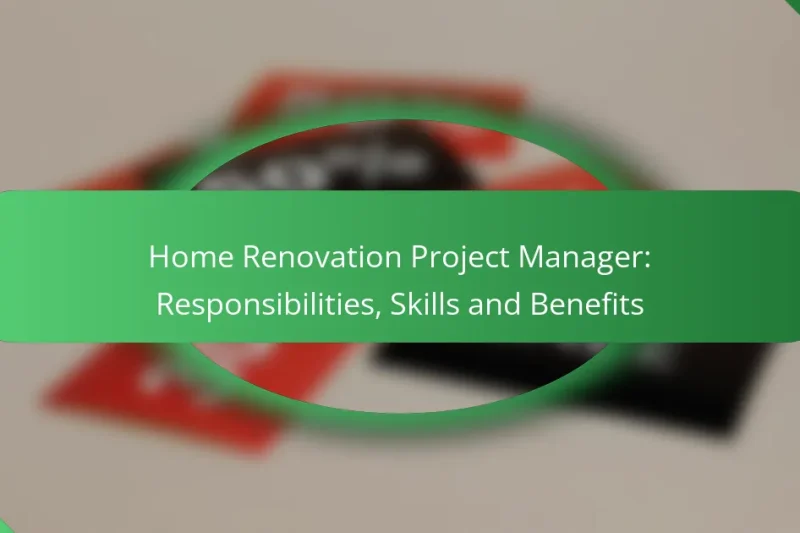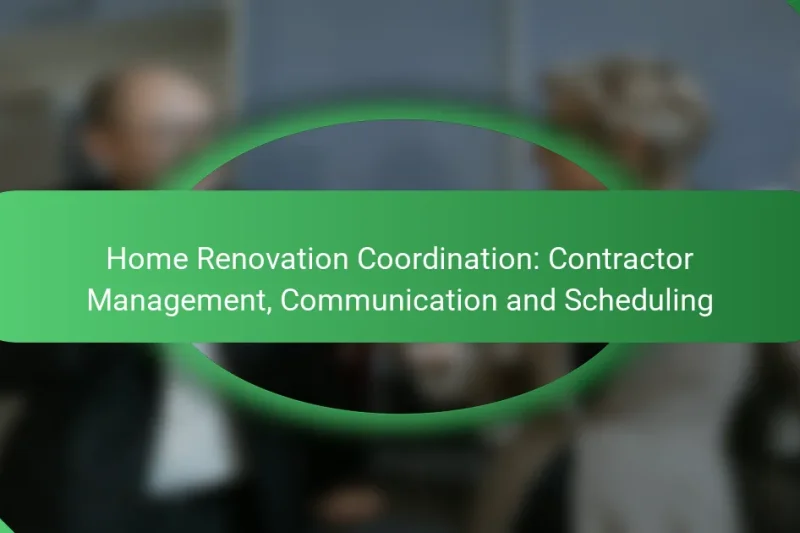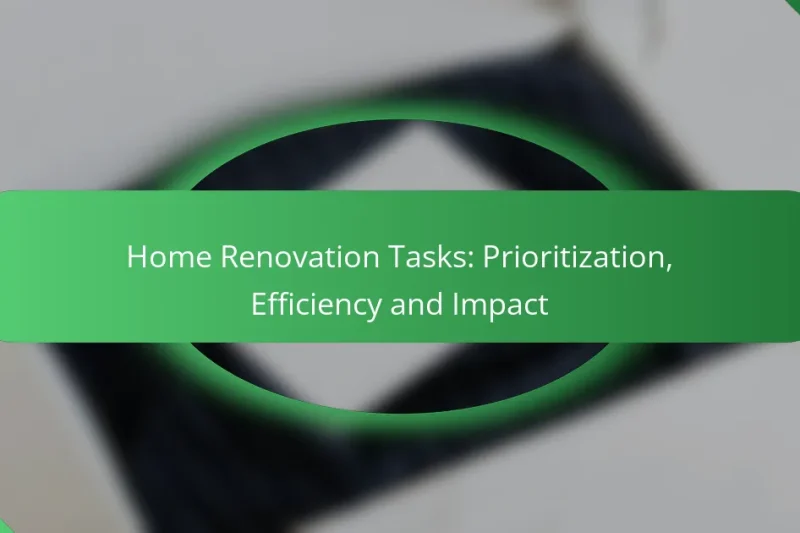Home renovation delays can significantly impact your project timeline and budget, often arising from issues such … Home Renovation Delays: Causes, Solutions and Timeline AdjustmentsRead more
Home Renovation Project Management Strategies
Managing a home renovation project requires strategic planning and the right methodologies to ensure success. By employing approaches such as Agile, Waterfall, or Hybrid, you can tailor your management style to fit the unique demands of your project. Additionally, creating a detailed timeline and utilizing specialized tools can significantly enhance collaboration and keep your renovation on track and within budget.
Home Renovation Project Manager: Responsibilities, Skills and Benefits
A home renovation project manager plays a crucial role in the successful execution of renovation projects … Home Renovation Project Manager: Responsibilities, Skills and BenefitsRead more
Home Renovation Budget: Tools, Tracking and Cost Management
Embarking on a home renovation project requires careful financial planning to ensure you stay within budget. … Home Renovation Budget: Tools, Tracking and Cost ManagementRead more
Home Renovation Coordination: Contractor Management, Communication and Scheduling
Home renovation coordination requires effective contractor management, emphasizing clear communication and structured scheduling. By prioritizing organized … Home Renovation Coordination: Contractor Management, Communication and SchedulingRead more
Home Renovation Timeline: Phases, Milestones and Scheduling
Embarking on a home renovation project requires careful planning and an understanding of the timeline involved. … Home Renovation Timeline: Phases, Milestones and SchedulingRead more
Home Renovation Tasks: Prioritization, Efficiency and Impact
Home renovation tasks require careful prioritization to enhance functionality, energy efficiency, and property value. Focusing on … Home Renovation Tasks: Prioritization, Efficiency and ImpactRead more
What are the best home renovation project management strategies?
The best home renovation project management strategies include Agile, Waterfall, and Hybrid approaches. Each method offers unique advantages and is suited to different project types, timelines, and team dynamics.
Agile project management
Agile project management focuses on flexibility and iterative progress through short cycles called sprints. This method allows teams to adapt to changes quickly, making it ideal for renovations where client preferences may evolve during the project.
In practice, Agile involves regular check-ins and updates, enabling quick adjustments based on feedback. For instance, if a homeowner decides to change materials mid-renovation, the team can pivot without significant delays.
To implement Agile effectively, ensure clear communication among all team members and set up a system for tracking progress and changes. Avoid common pitfalls like scope creep by defining clear project boundaries at the outset.
Waterfall project management
Waterfall project management is a linear approach where each phase must be completed before moving to the next. This method is suitable for renovations with well-defined requirements and minimal expected changes.
For example, if a kitchen remodel has a fixed design and budget, the Waterfall method allows for a structured timeline and clear milestones. Each phase, such as design, demolition, and construction, is completed sequentially, which can simplify scheduling and resource allocation.
However, be cautious of rigidity; unexpected issues can arise that may require revisiting earlier phases. To mitigate this, maintain a contingency budget of around 10-15% of the total project cost for unforeseen expenses.
Hybrid project management
Hybrid project management combines elements of both Agile and Waterfall methodologies, offering flexibility while maintaining structure. This approach is beneficial for complex renovations that require both detailed planning and adaptability.
For instance, a home addition might follow a Waterfall approach for the foundational work while using Agile for interior design choices that may change based on client feedback. This allows teams to manage predictable tasks efficiently while remaining responsive to client needs.
To successfully implement a Hybrid strategy, clearly define which aspects of the project will follow Agile and which will adhere to Waterfall principles. Regularly review progress and be prepared to adjust your approach as necessary to ensure project success.
How to create a renovation project timeline in Canada?
Creating a renovation project timeline in Canada involves outlining key phases, setting deadlines, and accounting for local regulations. A well-structured timeline helps ensure that the project stays on track and within budget.
Define project phases
Defining project phases is crucial for organizing the renovation process. Common phases include planning, design, demolition, construction, and finishing. Each phase should have clear objectives and deliverables to guide the project.
For example, during the planning phase, you might conduct a site assessment and finalize your budget. In the construction phase, you would focus on actual building work, ensuring that all tasks align with the overall timeline.
Set milestones and deadlines
Setting milestones and deadlines helps keep the renovation project on schedule. Milestones are significant points in the project, such as completing the design or finishing the framing. Assign realistic deadlines to each milestone to maintain momentum.
For instance, you could set a milestone to complete demolition within two weeks. Regularly review these deadlines and adjust them as necessary to accommodate any unforeseen challenges, such as delays in material delivery or weather-related issues.
What tools can assist with home renovation project management?
Effective home renovation project management can be greatly enhanced by using specialized tools that streamline tasks, improve collaboration, and facilitate scheduling. Selecting the right tool depends on the specific needs of your project, such as team size, complexity, and budget.
Trello for task management
Trello is a visual project management tool that uses boards, lists, and cards to organize tasks. Each card can represent a specific task, allowing team members to track progress and deadlines easily. This tool is particularly useful for smaller teams or individual projects where visual organization can enhance clarity.
To get started with Trello, create a board for your renovation project and set up lists for different stages, such as “To Do,” “In Progress,” and “Completed.” You can assign tasks to team members, set due dates, and attach relevant documents or images, making it a versatile choice for managing renovation tasks.
Asana for team collaboration
Asana is designed for team collaboration, making it ideal for larger renovation projects involving multiple stakeholders. It allows users to create tasks, assign them to team members, and set deadlines, ensuring everyone is on the same page. The ability to comment directly on tasks helps maintain clear communication throughout the project.
When using Asana, consider creating sections for different phases of the renovation, such as design, construction, and finishing touches. This organization helps teams focus on specific areas while keeping track of overall progress. Regularly updating tasks and checking in with team members can prevent bottlenecks and keep the project on schedule.
Microsoft Project for scheduling
Microsoft Project is a robust scheduling tool that provides advanced features for planning and tracking project timelines. It allows users to create detailed schedules, allocate resources, and visualize project timelines through Gantt charts. This tool is particularly beneficial for complex renovation projects that require precise scheduling and resource management.
To effectively use Microsoft Project, start by defining all tasks and their dependencies. This will help you identify critical paths and potential delays. Regularly update the project schedule to reflect changes and ensure that all team members are aware of their responsibilities and deadlines. Be mindful that this tool may have a steeper learning curve compared to others, so consider training or tutorials if needed.
How to budget for a home renovation project?
To budget for a home renovation project, start by determining the overall costs and setting aside funds for unexpected expenses. A well-planned budget will help you manage your finances and ensure the project stays on track.
Estimate costs accurately
Accurate cost estimation is crucial for a successful renovation budget. Begin by researching the average costs of materials and labor in your area. For example, kitchen renovations can range from a few thousand to tens of thousands of dollars depending on the scope and quality of materials.
Consider breaking down the project into specific tasks, such as demolition, plumbing, and electrical work. This detailed approach allows for more precise budgeting and helps identify areas where you might save money.
Include contingency funds
Including contingency funds in your renovation budget is essential to cover unexpected costs. A common recommendation is to set aside 10-20% of your total budget for contingencies. This buffer can help manage surprises like hidden damage or price increases in materials.
When planning your budget, communicate with your contractors about potential risks and their experience with similar projects. This dialogue can provide insights into what contingencies might be necessary based on past projects in your area.
What are the common challenges in home renovation project management?
Home renovation project management often faces several challenges that can hinder progress and increase costs. Key issues include scope creep, communication problems, and delays in material delivery, all of which can complicate the overall management process.
Scope creep
Scope creep refers to the gradual expansion of a project’s goals beyond the original plan, often without proper approval or adjustment to the budget. This can lead to increased costs and extended timelines, making it critical to define project boundaries clearly from the start.
To manage scope creep effectively, establish a detailed project scope document that outlines specific tasks, responsibilities, and deliverables. Regularly review this document with all stakeholders to ensure alignment and address any proposed changes formally.
Communication issues
Poor communication can lead to misunderstandings, mistakes, and frustration among team members and stakeholders. Clear and consistent communication is essential to keep everyone informed about project updates, changes, and expectations.
Implement regular meetings and updates to discuss progress and address concerns. Utilize project management tools that facilitate communication, such as shared calendars and messaging apps, to ensure everyone is on the same page.
Delays in material delivery
Delays in material delivery can significantly impact renovation timelines, leading to project stalls and increased costs. Factors contributing to these delays may include supplier issues, shipping problems, or unexpected demand fluctuations.
To mitigate the risk of delays, order materials well in advance and establish relationships with reliable suppliers. Consider using local suppliers to reduce shipping times and keep a buffer stock of essential materials to avoid project interruptions.
How to select the right contractors for renovations?
Selecting the right contractors for renovations is crucial to ensure your project runs smoothly and meets your expectations. Focus on their experience, reputation, and ability to communicate effectively throughout the renovation process.
Check references and reviews
Before hiring a contractor, it’s essential to check their references and read reviews from previous clients. Look for feedback on their work quality, timeliness, and professionalism. Websites like Yelp, Google Reviews, and Angie’s List can provide valuable insights.
Request at least three references from the contractor and contact them to ask specific questions about their experience. Inquire about the contractor’s ability to stay on budget and schedule, as well as how they handled any issues that arose during the project.
Assess qualifications and licenses
Ensure that the contractors you consider have the necessary qualifications and licenses required in your area. Most states or regions have specific licensing requirements for contractors, which can include general liability insurance and workers’ compensation coverage.
Ask to see copies of their licenses and verify them with local authorities. Additionally, consider their experience in similar renovation projects. A contractor with a proven track record in your type of renovation—be it kitchen, bathroom, or whole-home—will likely deliver better results.
What are the essential skills for a renovation project manager?
A renovation project manager needs a blend of technical, organizational, and interpersonal skills. Key abilities include project planning, budgeting, communication, and problem-solving to ensure the renovation runs smoothly and meets client expectations.
Project Planning
Effective project planning is crucial for a renovation project manager. This involves defining the project scope, setting timelines, and allocating resources efficiently. A well-structured plan helps keep the project on track and minimizes delays.
Consider using project management software to create timelines and track progress. Tools like Gantt charts can visually represent tasks and deadlines, making it easier to manage multiple aspects of the renovation simultaneously.
Budgeting
Budgeting is a vital skill for managing renovation costs. A project manager must estimate expenses accurately, monitor spending, and adjust as necessary to avoid overruns. This requires a good understanding of materials, labor costs, and potential unforeseen expenses.
To maintain control over the budget, create a detailed budget plan that includes all aspects of the renovation. Regularly review actual spending against the budget to identify any discrepancies early on.
Communication
Strong communication skills are essential for a renovation project manager to coordinate with clients, contractors, and suppliers. Clear communication helps ensure everyone is on the same page regarding project goals, timelines, and expectations.
Establish regular check-ins with your team and stakeholders to discuss progress and address any issues. Using collaborative tools can facilitate communication and keep all parties informed throughout the project.
Problem-Solving
Problem-solving abilities are critical when unexpected challenges arise during a renovation. A project manager must quickly assess situations, identify solutions, and implement changes without derailing the project timeline.
Develop a proactive mindset by anticipating potential issues and having contingency plans in place. This approach can help mitigate risks and ensure the project stays on track even when faced with obstacles.




